The US is a place where you can see and do a lot of things and Oklahoma is no exception. It’s no wonder that people want to capture everything. Sometimes, they even use their drones to spy on restricted areas and other people’s personal properties. This prompted the Federal Aviation Administration (FAA) to make some rules to regulate the activities of drone users. Aside from the laws made by the FAA, Oklahoma’s governing body also made some laws for its state.
So, in this article, we’ll be discussing all the Oklahoma drone laws in order for you to know your limits. An example of a limitation is not being allowed to fly your drone over any structure that has a fence. If you can’t make your way physically into the area, then your drone giving you access to the interior is illegal.
Now, let’s get started fully!
These are drone laws that are made by the FAA and they apply to every state in the US, including Oklahoma. FAA drone regulations include three major reasons for owning a drone – for commercial purposes, as a hobby, and as a government employee.



As confirmed by the Oklahoma Department of Transportation (ODT) and the Oklahoma Legislature, there is only one state-wide law concerning the flying of drones in Oklahoma, which is HB 2559 (2016). The contents of this House Bill (HB) are specifically meant for Oklahoma inhabitants.
According to HB 2559 (2016), any unmanned aircraft cannot be flown over any of Oklahoma’s critical facilities. Unmanned aircraft operating within 400 feet above ground level are subject to the flight limit. The goal of this state statute is to protect critical facilities against interference, damage, and disruption.
You must alert either the airport air traffic control tower or the airport operator, regardless of which local airport you’re flying close to and possibly breaching airspace. You’ll have to work out an operating procedure with airport air traffic or the airport operator, as well as answer a few questions. An example is inquiries about how long you plan to remain in the air.
This does not apply only to Oklahoma, but all the states in the US. It’s in the Special Rule for Model Aircraft contained in Part 101 of the Act to ensure that drone operations are disapproved before the drone can be deployed.
Also, note that in cases where the state and federal laws clash, the latter will be considered first.
These are laws that are enacted by a variety of agencies within the state of Oklahoma. These Oklahoma drone laws apply specifically to certain cities, regions, or counties.
However, there is yet to be any law governing the flying of drones in local areas of the state.
The FAA manages a number of programs that help to keep civil aviation safe. Among the programs are:
The FAA is dedicated to maintaining safe and navigable airspace. They design technologies to monitor air traffic and assign the use of airspace, as well as formulate air traffic laws.
The operation and maintenance of all the networks of optical and technological aid that are required for safe airplane navigation such as radar facilities, voice communication, and visual display are controlled by the FAA.
The Federal Aviation Administration is also involved in international civil aviation, supporting safety and proper training. Certification of foreign repair stations, airmen, mechanics, and technicians is part of this process.
These are the FAA regulations for small Unmanned Aircraft Systems (UAS) such as drones. They are divided into four main sections – operational limitations, operator certificate and responsibilities, aircraft requirements, and model aircraft.
The laws of these four sections are stated below.
This part covers the FAA rules on initiating, conducting, and terminating a flight. It has to do with the rules, safety measures, and limitations that must be adhered to if you must fly a small Unmanned Aircraft System in the US.
 The unmanned aircraft should be close to the operator at all times. The operator shouldn’t have to make use of other technology like a telescope before he can see the aircraft.
The unmanned aircraft should be close to the operator at all times. The operator shouldn’t have to make use of other technology like a telescope before he can see the aircraft. At any given time, no one is allowed to function as an operator or visual observer for more than one unmanned aircraft operation.
At any given time, no one is allowed to function as an operator or visual observer for more than one unmanned aircraft operation.This section has to do with the knowledge, skills, and certifications the aircraft pilot must have. It also has to do with the roles pilots are meant to perform before, during, and after a flight.
Pilots of small unmanned aircraft are to be called “operators.”
Operators are to:
 Aircraft Requirements
Aircraft RequirementsThese regulations have to do with the state of the aircraft. The aircraft must be in good shape to fly.
These are rules that are binding on model aircraft.
All owners of small Unmanned Aircraft Systems (UAS) are required by the Federal Aviation Administration (FAA) to register their aircraft. Also, the FAA mandates strict adherence to the stipulated rules and legislation.
To get a drone pilot license in Oklahoma, you’ll need to provide your name, home address, and email address. Note that you must be at least 13 years old before you get to register.
You’ll get a Certificate of Aircraft Registration and Proof of Ownership after that. In these documents, you’ll have your aircraft identification number. This number must be visible on your drone all the time. The identification number is effective for a maximum of three years.
Also, all drones weighing more than 250 grams will be registered with an extra fee, including any other payloads, such as an onboard camera. According to most reviews, having the Holy Stone Drone or the DJI Mini 2 is the best as it ticks all the necessary boxes and wouldn’t cause you extra funds during registration.
The video below covers the most common drone flying mistakes you can make.
On the whole, it is not restricted to fly a drone over private property in Oklahoma except in rural areas (according to Oklahoma state laws). However, during the flight, you should maintain a certain height and don’t pilot a drone below it. It is also forbidden to hover around private property and capture or record the owners without their permission.
The Federal Aviation Administration’s safety requirements and minimum criteria apply to all UAS manufactured, operations, and maintenance. Airports, pilots, and aircraft maintenance personnel are all certified by the FAA.
Oklahoma also made some laws for the safe flight of drones within the state. These Oklahoma drone laws are binding on all the inhabitants of the state. Firstly, if you wish to fly a drone either for commercial purposes, as a hobby, or as a government employee, you must get yourself registered.
After registration comes adherence to the state-wide law – House Bill 2559 (2016). The major goal of this statute is to ensure a safe flight at all times and to prevent interference with critical facilities.